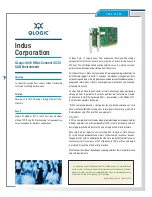
7 M-series switches and fabric rules
This chapter describes the M-series switches and the fabric rules for building M-series fabrics. It
describes the following topics:
• M-series switches
, page 157
• Fibre Channel fabric rules
, page 161
NOTE:
See “
SAN fabric connectivity and switch interoperability rules
” on page 167 for information about
using switches from the different series in the same SAN or the same fabric.
M-series switches
M-series switches:
•
Can be core or edge switches. When configured in a core-edge fabric topology, a
core switch
typically connects to other switches in the SAN; an
edge switch
typically connects to servers and
storage.
•
Have 10, 12, 24, 32, 64, or 140 ports.
•
Include entry-level and high-availability switches.
•
Use the same level of internal firmware for the same switch models.
•
Support plug-and-play compatibility.
•
Support iSCSI (see “
iSCSI storage
” on page 355) and FCIP (see “
SAN extension
” on page 279).
Contact an HP storage representative for information about switch model support with iSCSI and
FCIP.
The M-series switches offer:
•
High availability
•
Scalability
•
Cost efficiency
SAN Design Reference Guide
157
Summary of Contents for StorageWorks 4000/6000/8000 - Enterprise Virtual Arrays
Page 26: ......
Page 34: ...SAN design overview 34 ...
Page 60: ...SAN fabric topologies 60 ...
Page 80: ...Fibre Channel routing 80 ...
Page 82: ......
Page 92: ...H series switches and fabric rules 92 ...
Page 156: ...C series switches and fabric rules 156 ...
Page 182: ...SAN fabric connectivity and switch interoperability rules 182 ...
Page 184: ......
Page 270: ...XP and VA storage system rules 270 ...
Page 276: ...Enterprise Backup Solution 276 ...
Page 278: ......
Page 354: ...SAN extension 354 ...
Page 398: ...Network Attached Storage 398 ...
Page 400: ......
Page 416: ...Storage security 416 ...
Page 428: ...Best practices 428 ...
Page 456: ...456 ...
















































